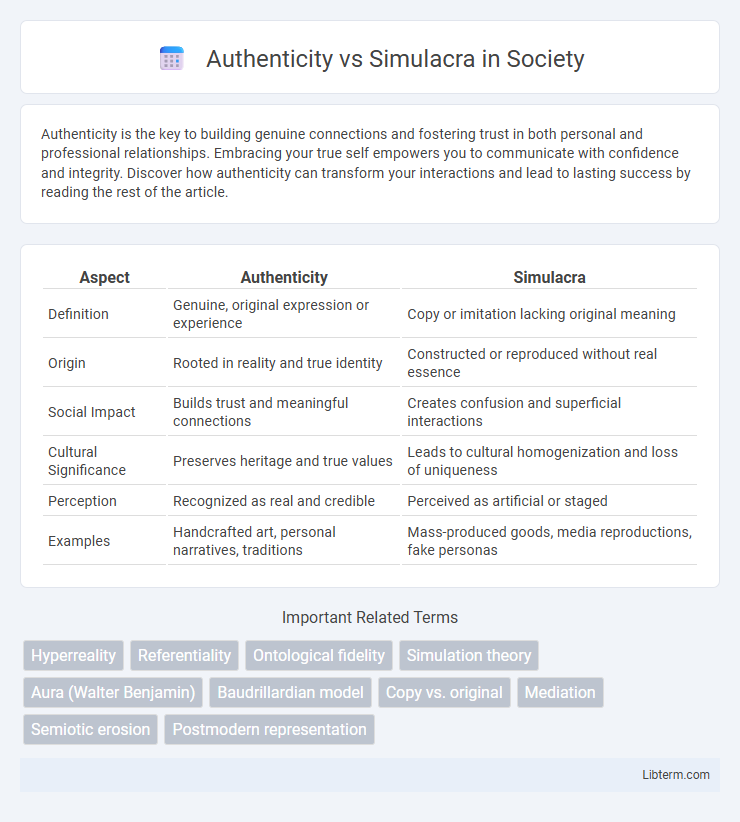Authenticity is the key to building genuine connections and fostering trust in both personal and professional relationships. Embracing your true self empowers you to communicate with confidence and integrity. Discover how authenticity can transform your interactions and lead to lasting success by reading the rest of the article.
Table of Comparison
| Aspect | Authenticity | Simulacra |
|---|---|---|
| Definition | Genuine, original expression or experience | Copy or imitation lacking original meaning |
| Origin | Rooted in reality and true identity | Constructed or reproduced without real essence |
| Social Impact | Builds trust and meaningful connections | Creates confusion and superficial interactions |
| Cultural Significance | Preserves heritage and true values | Leads to cultural homogenization and loss of uniqueness |
| Perception | Recognized as real and credible | Perceived as artificial or staged |
| Examples | Handcrafted art, personal narratives, traditions | Mass-produced goods, media reproductions, fake personas |
Defining Authenticity in the Modern World
Authenticity in the modern world is defined by the genuine origin, uniqueness, and truthful representation of an object, experience, or identity amid mass production and digital replication. The concept contrasts sharply with simulacra, which are copies or imitations lacking an original reference point, as theorized by Jean Baudrillard. Emphasizing personal experience, cultural context, and historical continuity ensures authenticity remains a valued standard in consumerism, art, and social interactions.
Understanding Simulacra: Origins and Concepts
Simulacra originate from the philosophical theories of Jean Baudrillard, who emphasized the representation of reality through copies without an original. These concepts explore how modern society replaces genuine experiences with manufactured imitations, leading to a hyperreal state where distinctions between reality and simulation blur. Understanding simulacra involves analyzing media, culture, and technology's roles in creating perceived realities detached from authentic existence.
Historical Context: Authenticity Across Ages
Authenticity has evolved from ancient cultural artifacts valued for original craftsmanship to modern critiques of simulacra, where copies replace genuine experience. Philosophers like Walter Benjamin emphasized the "aura" of authentic objects, which diminishes in mass reproduction, highlighting the historical tension between originality and imitation. This perspective reveals how societies across ages grapple with preserving authenticity amid technological and cultural shifts that blur the line between real and replicated.
The Role of Media in Creating Simulacra
Media plays a crucial role in creating simulacra by producing representations that often detach from original realities, leading audiences to consume signs and images as truths. Through relentless reproduction and circulation of these mediated images, reality becomes replaced with hyperreal simulations, where the distinction between authentic experiences and fabricated ones blurs. This process reinforces Baudrillard's theory that media constructs a world of simulacra, shaping perceptions and social realities without reference to any authentic origin.
Hyperreality: When Fakes Become Reality
Hyperreality describes a condition where simulations or copies replace and become more real than the original, blurring the line between authenticity and imitation. In this state, signs and symbols no longer refer to a real object but generate a self-contained reality, creating experiences that feel more meaningful than genuine ones. The prevalence of hyperreality challenges traditional notions of authenticity, as fabricated representations gain precedence over true existence in culture, media, and consumerism.
Authenticity in Art and Culture
Authenticity in art and culture signifies originality and genuine expression, emphasizing the unique creative process and cultural heritage behind a work. It ensures the preservation of historical context, artistic intent, and cultural identity, distinguishing genuine artifacts from mere replicas or imitations. Embracing authenticity fosters deeper emotional connections and cultural understanding, enhancing the value and significance of artistic works.
Simulacra in the Digital Age
Simulacra in the digital age manifest as hyperreal representations that replace genuine experiences with superficial copies, driven by social media, virtual realities, and algorithmic content curation. Platforms like Instagram and TikTok amplify constructed personas, blurring the line between reality and simulation, while NFTs (non-fungible tokens) create digital objects whose value is derived more from perceived authenticity than intrinsic qualities. This digital simulacrum challenges traditional notions of identity and authenticity, creating environments where the imitation often becomes more influential than the original.
The Impact on Personal Identity
Authenticity shapes personal identity by fostering a genuine sense of self grounded in unique experiences and intrinsic values. Simulacra, characterized by replicas of reality devoid of original meaning, disrupt this formation by promoting superficial identities based on external images and societal expectations. The clash between authentic selfhood and simulated personas challenges individuals to discern and maintain their true identity amidst pervasive cultural representations.
Authentic Experiences vs Constructed Realities
Authentic experiences emerge from genuine interactions and sensory engagement, reflecting true cultural, emotional, or historical contexts. Constructed realities, shaped by media, technology, or simulation, often prioritize curated or replicated environments that mimic authenticity but lack intrinsic originality. The tension between these concepts highlights the value of subjective truth against fabricated representations in shaping perception and identity.
Navigating Authenticity in a Simulated Society
Navigating authenticity in a simulated society requires recognizing the blurred lines between genuine experiences and their reproduced imitations, as theorized by Jean Baudrillard's concept of simulacra. This involves critical awareness of how media, social platforms, and consumer culture perpetuate hyperreality, where signs and symbols replace direct reality. Emphasizing self-reflection and discerning personal values helps maintain authenticity amid pervasive simulation and constructed identities.
Authenticity Infographic

 libterm.com
libterm.com